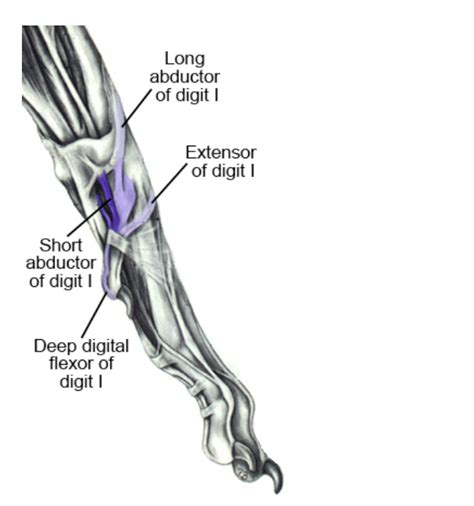The function of front dewclaws

Five tendons attach to the dewclaw and play an important role when the dog is in motion. For example:
- When a dog’s lead leg is on the ground during the gallop or canter, the dewclaw is on the ground to stabilize the carpus
- When a dog turns, the dewclaw digs into the ground to support the structures of the limb and prevent torque
- Some dogs also use their dewclaws to help them climb trees and out of water, or hold items as they chew
If a dog does not have dewclaws, there is a higher potential for the carpal ligaments to stretch and tear which could result in laxity and arthritis over time (OUCH!). This can then result in more stress being generated through the dog’s carpus, elbow, shoulder, and spine as it tries to compensate for the lack of digit.
The Research Behind Digit Injuries
A 2018 study of digit injuries found that digit injuries were more likely to occur in the front limbs (P< 0.001) than hind and that digit 5 (the outside digit) was the most frequently injured while the dewclaw (digit 1) was the least frequently injured.
Previous research has thought that our dog’s third and fourth digit were the most important due to their central location within the feet and due to their length in comparison to other toes but research has shown that substantial weight is also placed on the fifth pad and on the metacarpophalangeal and metatarsophalangeal pads. This observation was also found within the present study with digit 5 seeing the most amount of injury. The researchers suggested that forces applied when dogs are turning at high speeds on the agility course may act as repetitive stressors to digits 3, 4, and 5 and that these digits may be of more importance to athletic function than previously recognized.
Of particular note is the research found that the first digit (the dewclaw) was at a low risk of injury. The results of the study suggested that the removal of the dewclaws in the forelimb may be a risk factor for injury to other digits. The front dewclaws may have a function in preventing torque on the limb, and as such, the removal of dewclaws may predispose the dog to injury.
Source: Cullen KL, Dickey JP, Bent LR, Thomason JJ, MoÃns NM. Survey-based analysis of risk factors for injury among dogs participating in agility training and competition events. J Am Vet Med Assoc. 2013;243:1019-24.
Why do some advocate front dewclaw removal?
There are a number of reasons why someone may choose to remove front dewclaws from their dog. Breeders may choose to remove dewclaws on 3-5 day old puppies or owners may choose to remove front dewclaws later in life. This choice can be very personal and can vary between owners, breeders, veterinarians and dog breeds. So what are some of the reason behind removal?
- Belief that front dewclaws are a non-functional digit. For many years, people believed that because the nail of the dewclaw doesn’t touch the ground in standing that it must not have a real purpose and therefore removal of the nail wouldn’t impact the dog in any way. Rear dewclaws, on the other hand, do not have any associated tendons and are considered non-functional (though they may be required for some breed standards to be present).
- Breeders fear pet owners won’t cut dewclaws or will miss them. Some breeders fear that pet owners will miss the dewclaw when trimming their dogs nails and risk the nail becoming embedded or ripping.
- Cleaner front look. In the conformation ring some breeders and owners feel that the dewclaw detracts from the dog’s overall appearance.
- Risk of injury and fear of the dog ripping their dewclaw. Some feel that the dewclaw is an unnecessary risk and remove the nail to prevent potential injury.
How to Avoid Injury to the Dewclaw
Keeping the nail short is key to avoiding injury with dewclaws! Like other toenails the nail of dewclaw needs to be trimmed regularly but due to the location of the dewclaw the nail will not make contact with the ground and will not wear down naturally like other toenails. Left untrimmed the nail can curve down and become ingrown, risking infection. Untrimmed, the nail will also develop a longer quick making it difficult to maintain proper length. Long dewclaws also have a greater risk of catching on things and risk injury. Speaking with vets, you may be surprised at how few dewclaw injuries they see in dogs with well managed nails.
Another important factor in reducing injury to this nail is to educate owners! If removal of the dewclaw is done because of a fear that new owners will fail to properly maintain them then I would argue that breeders need to do more to educate their puppy owners about the location and care of dewclaws.
While I would prefer not to remove dewclaws from dogs all three of my own dogs have had them removed by their breeders. So, knowing what we do about the function of dewclaws in reducing force how can I help my dogs minimize the extra force they experience on their shoulder complex? Thankfully, there are a number of conditioning exercises we can do to help dogs with missing front dewclaws. Exercises that strengthen the scapular muscles of the shoulder such as side-stepping, tight turns with cookies, and weight shifting work can all help to reduce the risk of to the forelimb and shoulder.
If you would like to see more about the function of dewclaws and see dewclaws in action make sure to check out the videos below! If you would like to learn more about how to help your dog compensate for their dewclaw removal please don’t hesitate to contact me for help!